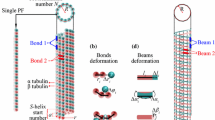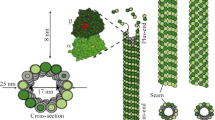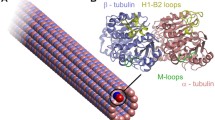Abstract
A molecular structural mechanics (MSM) method has been implemented to investigate the free vibration of microtubules (MTs). The emphasis is placed on the effects of the configuration and the imperfect boundaries of MTs. It is shown that the influence of protofilament number on the fundamental frequency is strong, while the effect of helix-start number is almost negligible. The fundamental frequency is also found to decrease as the number of the blocked filaments at boundaries decreases. Subsequently, the Euler–Bernoulli beam theory is employed to reveal the physics behind the simulation results. Fitting the Euler–Bernoulli beam into the MSM data leads to an explicit formula for the fundamental frequency of MTs with various configurations and identifies a possible correlation between the imperfect boundary conditions and the length-dependent bending stiffness of MTs reported in experiments.







Similar content being viewed by others
References
Behrens S, Wu J, Habicht W, Unger E (2004) Silver nanoparticle and nanowire formation by microtubule templates. Chem Mater 16:3085–3090
Brangwynne CP, Koenderink GH, Barry E, Dogic Z, MacKintosh FC, Weitz DA (2007) Bending dynamics of fluctuating biopolymers probed by automated high-resolution filament tracking. Biophys J 93:346–359
Chandran PL, Mofrad MRK (2009) Rods-on-string idealization captures semiflexible filament dynamics. Phys Rev E 79:011906
Chrétien D, Fuller SD (2000) Microtubules switch occasionally into unfavorable configurations during elongation. J Mol Biol 298:663–676
Chrétien D, Wade RH (1991) New data on the microtubule surface lattice. Biol Cell 71:161–174
Cifra M, Pokorný J, Havelka D, Kucera O (2010) Electric field generated by axial longitudinal vibration modes of microtubule. BioSyst 100:122–131
Daneshmand F, Amabili M (2012) Coupled oscillations of a protein microtubule immersed in cytoplasm: an orthotropic elastic shell modeling. J Biol Phys 38:429–448
Deriu MA, Soncini M, Orsi M, Patel M, Essex JW, Montevecchi FM, Redaelli A (2010) Anisotropic elastic network modeling of entire microtubules. Biophys J 99:2190–2199
Enemark S, Deriu MA, Soncini M, Redaelli A (2008) Mechanical model of the tubulin dimer based on molecular dynamics simulations. J Biomech Eng 130:041008
Gao YW, Lei FM (2009) Small scale effects on the mechanical behaviors of protein microtubules based on the nonlocal elasticity theory. Biochem Biophys Res Commun 387:467–471
Havelka D, Cifra M, Kučera O (2014) Multi-mode electro-mechanical vibrations of a microtubule: In silico demonstration of electric pulse moving along a microtubule. Appl Phys Lett 104:243702
Hawkins TL, Mirigian M, Li J, YasarMS SDL, Sept D, Ross JL (2012) Perturbations in microtubule mechanics from tubulin preparation. Cell Mol Bioeng 5:227–238
Hawkins TL, Sept D, Mogessie B, Straube A, Ross JL (2013) Mechanical properties of doubly stabilized microtubule filaments. Biophys J 104:1517–1528
Howard J (2001) Mechanics of motor proteins and the cytoskeleton. Sunderland, MA
Howard J, Hyman AA (2003) Dynamics and mechanics of the microtubule plus end. Nature 422:753–758
Hunyadi V, Chrétien D, Janosi IM (2005) Mechanical stress induced mechanism of microtubule catastrophes. J Mol Biol 348:927–938
Ji XY, Feng XQ (2011a) Coarse-grained mechanochemical model for simulating the dynamic behavior of microtubules. Phys Rev E 84:031933
Ji XY, Feng XQ (2011b) Mechanochemical modeling of dynamic microtubule growth involving sheet-to-tube transition. PLoS ONE 6:e29049
Jin MZ, Ru CQ (2014) Localized vibration of a microtubule surrounded by randomly distributed cross linkers. J Biomech Eng 136:071002
Kasas S, Cibert C, Kis A, Rios PDL, Riederer BM, Forro L, Dietler G, Catsicas S (2004a) Oscillation modes of microtubules. Biol Cell 96:697–700
Kasas S, Kis A, Riederer BM, Forro L, Dietler G, Catsicas S (2004b) Mechanical properties of microtubules explored using the finite elements method. Chem Phys Chem 5:252–257
Kawaguchi K, Yamaguchi A (2010) Temperature dependence rigidity of non-taxol stabilized single microtubules. Biochem Biophys Res Commun 402:66–69
Kis A, Kasas S, Babić B, Kulik AJ, Benoît SW, Briggs GAD, Schönenberger C, Catsicas S, Forró L (2002) Nanomechanics of microtubules. Phys Rev Lett 89:248101
Kis A, Kasas S, Kulik AJ, Catsicas S, Forró L (2008) Temperature-dependent elasticity of microtubules. Langmuir 24:6176–6181
Meurer-Grob P, Kasparian J, Wade RH (2001) Microtubule structure at improved resolution. Biochemistry 40:8000–8008
Pampaloni F, Lattanzi G, Jonas A, Surrey T, Frey E, Florin EL (2006) Thermal fluctuations of grafted microtubules provide evidence of a length-dependent persistence length. Proc Natl Acad Sci USA 103:10248–10253
Pokorný J, Jelínek F, Trkal V, Lamprecht I, Holzel R (1997) Vibrations in microtubules. Astrophy Space Sci 23:171–179
Pokorný J, Vedruccio C, Cifra M, Kučera O (2011) Cancer physics: diagnostics based on damped cellular elastoelectrical vibrations in microtubules. Eur Biophys J 40:747–759
Rappé AK, Casewit CJ, Colwell KS, Goddard Iii WA, Skiff WM (1992) UFF, a full periodic table force field for molecular mechanics and molecular dynamics simulations. J Am Chem Soc 114:10024–10035
Samarbakhsh A, Tuszynski JA (2011) Vibrational dynamics of bio- and nano-filaments in viscous solution subjected to ultrasound: implications for microtubules. Eur Biophys J 40:937–946
Sept D, MacKintosh FC (2010) Microtubule elasticity: connecting all-atom simulations with continuum mechanics. Phys Rev Lett 104:018101
Shen HS (2010) Nonlocal shear deformable shell model for postbuckling of axially compressed microtubules embedded in an elastic medium. Biomech Model Mechanobiol 9:345–357
Shen HS (2011) Nonlinear vibration of microtubules in living cells. Curr Appl Phys 11:812–821
Shi YJ, Guo WL, Ru CQ (2008) Relevance of Timoshenko-beam model to microtubules of low shear modulus. Phys E 41:213–219
Sim H, Sept D (2013) Properties of microtubules with isotropic and anisotropic mechanics. Cell Mol Bioeng 6:361–368
Taj M, Zhang JQ (2012) Analysis of vibrational behaviors of microtubules embedded within elastic medium by Pasternak model. Biochem Biophys Res Commun 424:89–93
Taute KM, Pampaloni F, Frey E, Florin EL (2008) Microtubule dynamics depart from the wormlike chain model. Phys Rev Lett 100:028102
Valdman D, Atzberger PJ, Yu D, Kuei S, Valentine MT (2012) Spectral analysis methods for the robust measurement of the flexural rigidity of biopolymers. Biophys J 102:1144–1153
Venier P, Maggs AC, Carlier MF, Pantaloni D (1994) Analysis of microtubule rigidity using hydrodynamic flow and thermal fluctuation. J Biol Chem 269:13353–13360
Wade RH (2009) On and around microtubules: an overview. Mol Biotechnol 43:177–191
Wang CY, Ru CQ, Mioduchowski A (2006) Vibration of microtubules as orthotropic elastic shells. Phys E 35:48–56
Wang CY, Li CF, Adhikari S (2009) Dynamic behaviors of microtubules in cytosol. J Biomech 42:1270–1274
Wang CY, Zhang LC (2008) Circumferential vibration of microtubules with long axial wavelength. J Biomech 41:1892–1896
Weaver W Jr, Timoshenko S, Young DH (1990) Vibration problems in engineering, 5th edn. Wiley, New York
Weaver W Jr, Gere JM (1990) Matrix analysis of framed structures, 3rd edn. Van Nostrand Reinhold, New York
Zhang J, Meguid SA (2014) Buckling of microtubules: An insight by molecular and continuum mechanics. Appl Phys Lett 105:173704
Zhang J, Wang CY (2014) Molecular structural mechanics model for the mechanical properties of microtubules. Biomech Model Mechanobiol 13:1175–1184
Author information
Authors and Affiliations
Corresponding author
Appendix
Appendix
The vibration solution to Eq. 8 can be found using the method of separation of variables as
Substituting Eq. 14 into Eq. 8 and rearranging yield
It is noted that the left term in Eq. 15 is independent with x, and the right term is independent with t. Thus, they should be equal to a constant, which is noted as \(-\omega ^{2}\). Here, \(\omega \) is known as the angular frequency \((f=\omega /2\pi )\).
Thus, Eq. 15 can be written as
where \(\tau ^{4}=\rho \omega ^{2}/D\).
The solution of Eq. 17 is given by
where \(C_{1}-C_{4}\) are constants. The constants \(C_{1}-C_{4}\) and \(\tau \) can be found from the boundary conditions. For the CM model of the MTs considered here, the boundary conditions can be stated as
Applying the above boundary conditions to Eq. 18 yields
Thus, we can get following characteristic equation
Rights and permissions
About this article
Cite this article
Zhang, J., Wang, C. Free vibration analysis of microtubules based on the molecular mechanics and continuum beam theory. Biomech Model Mechanobiol 15, 1069–1078 (2016). https://doi.org/10.1007/s10237-015-0744-3
Received:
Accepted:
Published:
Issue Date:
DOI: https://doi.org/10.1007/s10237-015-0744-3




